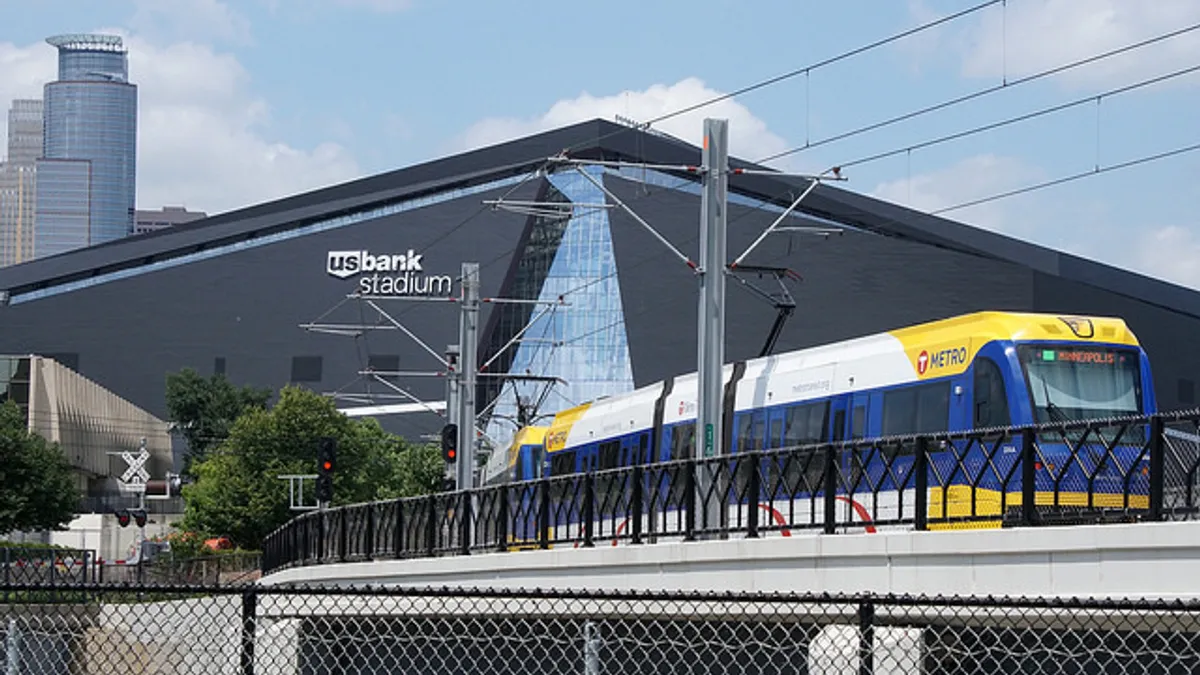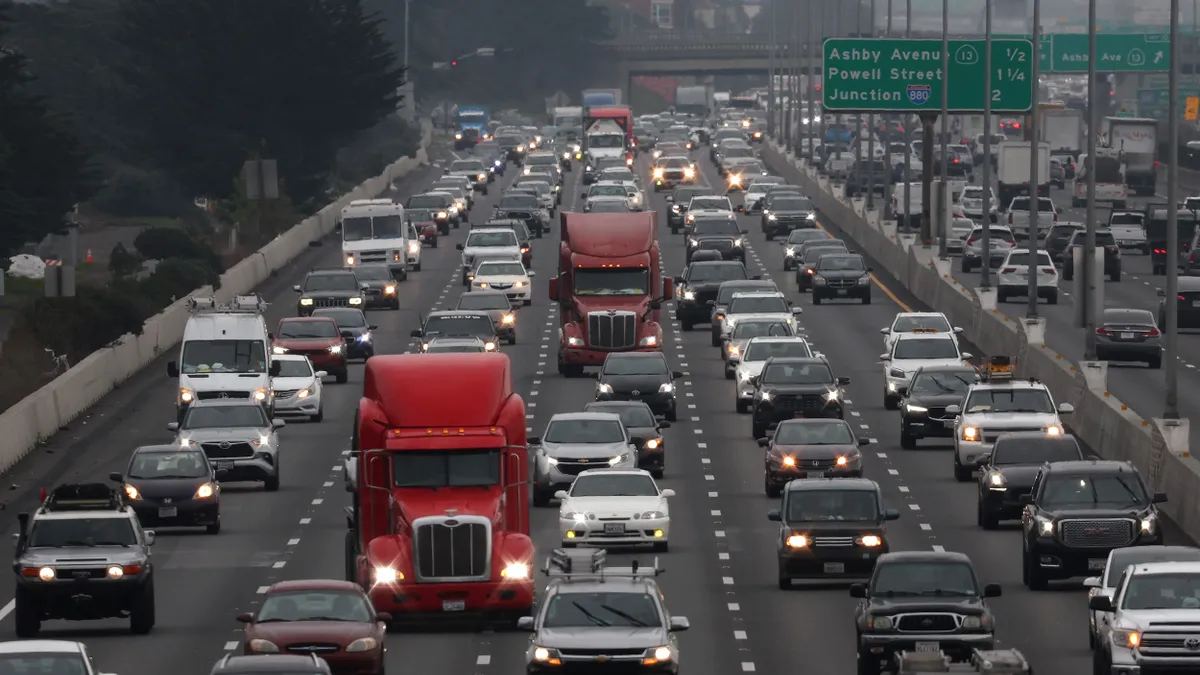On Sunday, an estimated 73,000 football fans will pack U.S. Bank Stadium in Minneapolis for the 2018 Super Bowl, an expansion of the stadium’s typical 65,000-person capacity.
That’s still only a fraction of the average 1 million people that typically travel to Super Bowl host locations to partake in the 10-day celebration surrounding the Big Game. Yet for a city of about 413,000 people — which shares a border with St. Paul, population 302,000 — it's a lot of extra volume to account for.
The stadium is unusual in its location, smack dab in downtown Minneapolis; few NFL stadiums are positioned right in the heart of urban areas. That will contribute to what Metro Transit leaders like Mark Benedict, director of light rail operations and transportation, consider "the most transit-reliant Super Bowl ever played."
Minneapolis has only hosted the Super Bowl once before, in 1992, and a lot has changed in the Twin Cities since that time. For one, the Metrodome is gone and U.S. Bank Stadium opened in 2016, around the same time when the city began developing transit plans for this year's Super Bowl. But more importantly for mobility, the region is now home to a light rail system.
Relying on light rail
The Twin Cities’ light rail system, which began operating in 2004, generally accounts for about 13% of Metro Transit’s total ridership — but it will be the transportation star on game day. "For most of the locations into U.S. Bank, we are sequestering the rail line" and pulling nearly all of the trains out of normal service to provide direct service to the game from two starting points, Benedict said. "All that we’ll be transporting by train will be ticket holders who also have in their possession this Metro Transit electronic ticket on their smart phones."
The travel route and all of the trains will have undergone pre-game day security screenings, but they will receive their final checks on Sunday morning, as will train operators and other transit agency staff.
Metro Transit has 5,000 game day tickets allotted for its Mall of America starting point and 15,000 for the Stadium Village location; it anticipates all of the tickets will be used. Rather than simply transporting fans to the game, the light rail system also will provide official security screening for the estimated 20,000 riders, who will not have to go through additional screening at the stadium.
The ticketed passengers at the light rail pick-up points "will go through magnetometers and standard screening protocols, just as they would if they were coming up to the stadium," Benedict said. "They’ll be queued in a secure area at the two locations and… will be loaded onto one of our secure trains that will operate down the secure corridor into U.S. Bank Stadium, which is within a secure perimeter."
The process eases the burden of on-site screening at the stadium. "There was concern that the footprint where the stadium sits is too small to have 70,000 to 80,000 people screened in the downtown area," Benedict said. "It’s really a value-added service from a customer standpoint, and… it solves a security problem."
"Post-game we’re going to pound the stadium with trains, one after another..."

Mark Benedict
Director of Light Rail Operations and Transportation, Metro Transit
To alleviate a crush of riders, the train tickets are distributed for specific one-hour time frames, such as from 1p.m. to 2 p.m. The transit authority wanted to know in advance approximately how many customers to expect from each direction and wanted to "use the ticketing as a method of metering them," Benedict said. "You can imagine we wouldn’t have the capacity to move 15,000 people if they all showed up at 4 p.m. for a 5:30 game."
During the game, security will break down and Metro Transit will "start packing those trains downtown, queuing them to prepare for post-game," Benedict said. Fans leaving the stadium will not need a special ticket, so the system might get more riders than the 20,000 before the event. “Post-game we’re going to pound the stadium with trains, one after another,” to get all the fans out quickly, he said.
In the months leading up to the Super Bowl, the transit agency hired a contractor to study electrification capacity and let Metro Transit know "how many trains we can get downtown powered up minimally so that the batteries keep charging and the heat is sufficient to keep them above 40 degrees," Benedict said. A test a few weeks ago confirmed the study’s results, that the city is "able to get 21 trains in there — 63 car sets — with no unexpected effect on our electrified grid in the downtown area."
Accommodating regular riders
Because the Twin Cities’ light rail system largely will be monopolized by Super Bowl activity on Sunday, the bus system has been reworked to accommodate regular transit riders. "We’re not promoting [the bus] as a way to get to the game," said Brian Funk, Metro Transit deputy chief operating officer for bus.
Traditional bus service leading up to and on game day remains focused on "regular customers who are loyal to us every day and are going to be going through challenges with street closures and [bus] stop closures and extra traffic," Funk said. "We have beefed up service on a number of our key local routes and… positioned buses and operators so we can plug in and hopefully save the day for our customers who are standing on the corner waiting for us."
Additional trips have been added on nine express routes serving the metro area’s largest park-and-ride facilities to ensure that residents "are either able to leave town early or stay late… and that gives them the option to get out of town before things are more congested if they have obligations," Funk said. "They know they’ll still have a bus ride home."
The park-and-rides are also considered a mode for traveling to the various celebrations throughout the 10-day event. Last week, weekend service began at five park-and-ride facilities throughout the metro region that will shuttle riders directly into and out of downtown Minneapolis and St. Paul. The service is modeled on the popular flat-rate shuttle that takes riders to and from the state fair in the summer.
Weather or not
The NFL usually doesn’t hold the Super Bowl in locations where the average game day temperature is below 50 degrees. In fact, only five previous Super Bowls have been played in cold winter climate cities: two in Detroit, one in New Jersey, one in Indianapolis and one in Minnesota.
It’s no secret that Minnesota has colder, snowier winters than much of the U.S., and that creates the need for more Super Bowl transportation contingency plans than in cities with temperate weather.
Light rail tracks remain snow-free just from running trains on them, so if it snows on Sunday, "we’ll keep a minimum amount of trains moving along those alignments to move the snow," Benedict said. Plus, to keep the trains powered, the agency will need to keep the overhead catenary system (OCS) clear of ice. "Most of our trains are outfitted with ice cutters that… run in tandem with the pantographs that capture the electricity off of the OCS [and] literally scrape the ice off of the OCS wire so we can maintain contact."
The bus system is more at the mercy of Mother Nature and road conditions, so it requires a bit more planning. For the past couple of weeks, key staff members have been getting twice-daily briefings on predicted weather conditions so the agency can make well-informed decisions in deploying resources. "We need to communicate with our customers and employees so everyone knows what to expect,” Funk said.
Learning from others
Despite the unique winter weather challenges, Metro Transit was able to learn a lot from other cities that had previously hosted the Super Bowl.
"...This is certainly about the game itself, but more than anything this is a 10-day event that descends into celebration across the region."

Brian Funk
Deputy Chief Operating Officer, Bus, Metro Transit
About a year and a half ago, leaders in the Twin Cities had a conference call with those in Santa Clara, CA, which hosted the Super Bowl at the San Francisco 49ers’ home stadium in 2016. Twin Cities Metro Transit employees also took a trip to Houston last year to see how that city’s system functioned during the event.
"The metro transit authority for Houston was very gracious… [and] we learned a tremendous amount," Benedict said. Takeaways included information about the "attitude of people on the trains, how they load and unload, what times of the day they experience volume… what game day looks like [and] what post game looks like.”
A primary lesson learned on the bus side was that "this is certainly about the game itself, but more than anything this is a 10-day event that descends into celebration across the region," Funk said. The scope of the celebrations and the throngs of visitors they bring require Metro Transit to “prepare our system for something unlike any other major event that we’ve hosted.”
Perhaps even more importantly, both Santa Clara and Houston illustrated that transit authorities should do as much as possible for loyal customers. "Our regular customers are the people who allow us to keep operating day in and day out," Funk said.
In addition to collaborating with other cities, Metro Transit has worked closely with other municipal departments and organizations within the Twin Cities. "The dozens of committee meetings and planning groups… [help to] figure out what’s going to work for everybody, what’s going to provide a safe and fun atmosphere for all the guests," Funk said. "Things have really come together nicely. We feel like we have an excellent plan in place and now it’s time to execute."




















